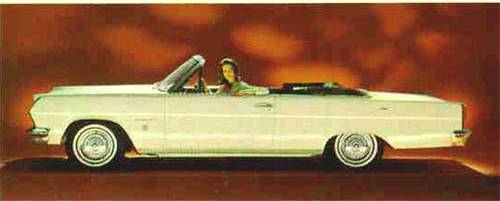By Brian Yacino
Brian’s tips & useful info about your Rambler
A Smokescreen From My Tailpipe!

Spring is coming. Let’s pretend that it finally stopped snowing
and you head out the garage or storage facility to fire up
the old “flivver”. Everything seems normal until you notice
that you’re getting gassed out by the smokiness of your tailpipe.
What’s up with that? Is it serious? Let’s see.
Black smoke: indicates unburned fuel is escaping through the exhaust.
We say that the engine is running “rich”. Common causes are a bad,
sticking, or unadjusted float / needle valve, a faulty choke mechanism, or
a clogged air filter. Check the air cleaner / filter first (that’s the big black
or red round thingy on top of the engine). Make sure that no critters have
built a winter condo inside the housing. With the air cleaner removed,
look into the top of the carburetor. That little “flipper-do” thing in the top
opening is the choke “butterfly”. It should be closed when the engine is
cold (to allow less air & more fuel in). As the engine warms, it should
open up until it’s sitting vertical, to let as much air in as possible. If the
needle valve / float has a problem, gas will usually start oozing out of
every nook and cranny of the carburetor and the car will stall.
Blue smoke: indicates oil burning. The tailpipe could either emit a puff of
blue at startup time, or smoke all the time. A puff at startup time is usually
something in the valve system - valve seals or valve guides. It doesn’t
necessarily mean that you need an expensive overhaul (at least not this
minute). If you get blue smoke all the time, that’s maybe more serious. If
the engine still runs ok, it’s probably worn piston rings (as opposed to broken
rings, bad piston, etc). It could possibly be stuck rings, in which case
they may unstick when you drive the car a little. A compression test can
tell you a lot about what the engine is doing. Consult your closest Rambler
professional, and have one done as soon as you can. In the meantime,
be sure to check the oil regularly so you don’t cause more damage
than you already have.
White smoke: could be normal for a cold engine that has been inactive
for a while. In that case, it would be just condensation, and should stop
as soon as the engine warms up enough to rid itself of the moisture. If it
continues, it could be a bad transmission modulator (allows the engine to
suck in and burn transmission fluid) or it could be coolant that is being
forced into the combustion chambers and being burned. The exhaust will
look wet and have a sweet smell to it. Possible causes if it’s coolant? It
could be a bad head gasket, warped head, or a cracked head or engine
block. Look for rising engine oil levels, and get it checked right away!
Brian